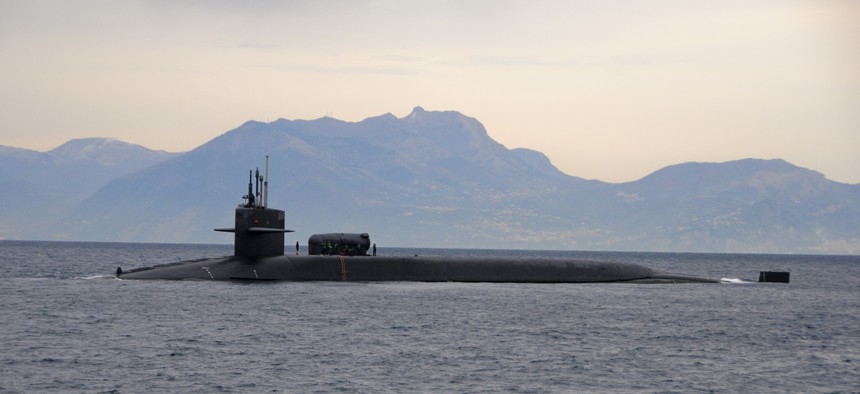
The USS Florida pulls into the Bay of Naples, on March 4, 2011. U.S. Navy photo by Mass Communication Specialist 2nd Class Daniel Viramontes
The Navy Can't Afford Its Own Plan to Buy New Subs
The Navy just told Congress the cost to build subs and modernize the rest of its fleet is 'unsustainable.' By Global Security Newswire
The U.S. Navy says that it cannot afford to simultaneously build a new strategic submarine fleet and to update the rest of its conventional ships.
In a July 1 report to Congress on its long-term shipbuilding plan, the Navy said by fiscal 2032 it would be spending in excess of $24 billion annually -- almost double the traditional average of $13 billion, Inside Defense reported. The sea service described that amount of funding as "unsustainable."
"There will be resourcing challenges outside the [fiscal 2015 - fiscal 2019 future years defense plan] largely due to investment requirements associated with the SSBN(X) requirement," wrote U.S. Deputy Defense Secretary Robert Work in the 28-page report. "SSBN(X)" refers to the planned successor class to the Ohio ballistic missile submarine.
The Navy's long-term shipbuilding plan does not factor in current defense spending caps imposed by the 2011 Budget Control Act.
Acquisition costs for the next-generation nuclear delivery vehicle are forecast in the report to boost yearly shipbuilding spending to an average of $19.7 billion yearly during the fiscal 2015 - fiscal 2019 period.
The need to modernize the U.S. strategic submarine fleet "will cause significant and noteworthy risks to the Navy's overall shipbuilding plan," the report says.
The projected cost of the lead SSBN(X) submarine also has increased, rising by about $400 million from last year's projection to $12.4 billion, according to the Navy.
There is a movement in both chambers of Congress to create a separate fund to pay for the new strategic submarine fleet in order to prevent the expense from swamping the Navy's shipbuilding budget. The Senate Armed Services Committee in May passed annual defense-authorization legislation that would require the establishment of a "National Sea-based Deterrence Fund." Legislation with a similar goal has already been approved by the House of Representatives.
Construction of the new submarine fleet is anticipated to begin in fiscal 2021. A total of 12 new vessels -- armed with nuclear-tipped Trident D-5 ballistic missiles -- are planned for acquisition.